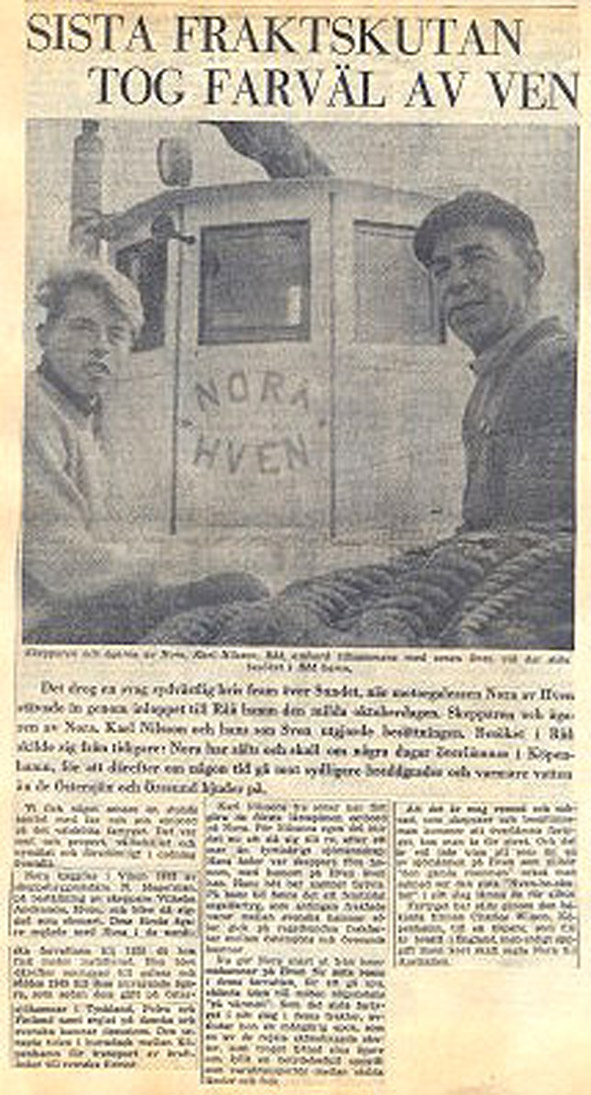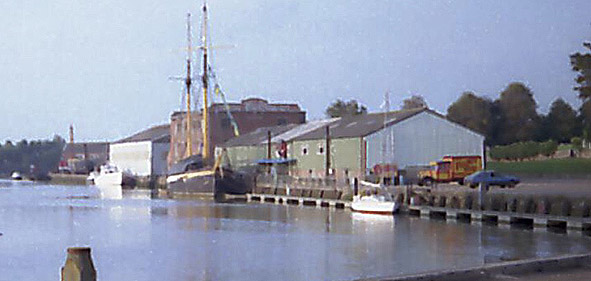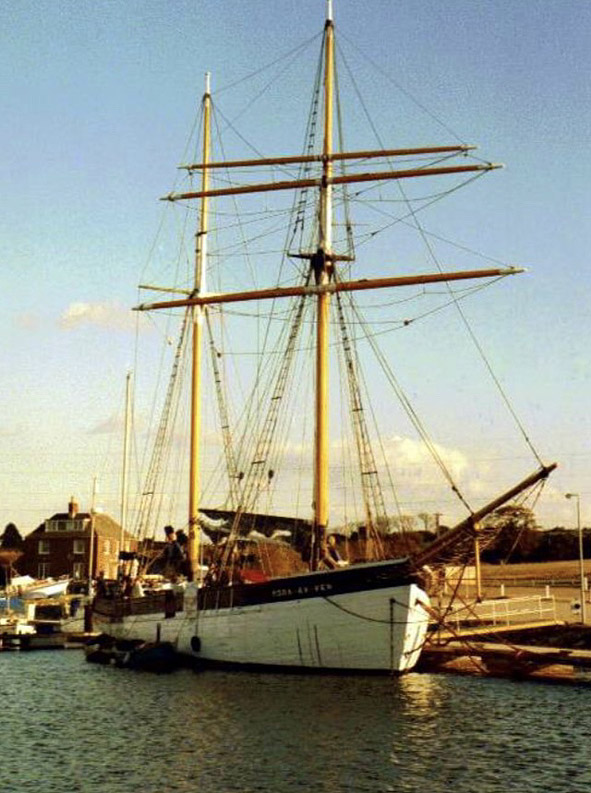

THE SAILING VESSEL NORA OF HVEN STORY ......Back to gallery
Link to "Voyages of the Nora Dane"
Further information
Courtesy
of: Swedish
Transport AgencyRegister officer
Civil Aviation and Maritime Department
The Swedish register of Shipping-Sjofartsregistret@transportstyrelsen.se
Galeas Nora Dane (ex. Nora fran Hven, ex. Nora av Ven) -Official nr: 5508 Signal letters: SJMI
Name of vessel: Nora.
EHK: 120.- Brutto gross: 89. - Netto grosse: 64.
Length: 23.29m. - Breadth: 6.77m. - Draft loaded: 3.00m.
Built material: EF (Timber). - Loading standards: 52.
Built in: Viken, Sweden by Janne Hagerman. - Port of registry: Ven. - Built for: Vilhelm Andersson
Owner: Karl Bernhard Nilsson of Raa, Sweden.
For more information, call Riksarkivet, our national archives.
Their telephone number is +46 10-476 70 00
For about 40 years, 1880 - 1920, a large number of ships of different sizes were built in Viken under the direction of shipbuilder Janne Hagerman. The largest of them were twelve three-masted schooners built during the years 1901-1918. He also built the Nora, Official nr: 5508, in 1913.
Courtesy of: fiskebatar.zaramis.se/varv/vikens-skeppsvarv/
Viken Sheppsvav (Viken Shipyard)
Viken är ett litet fiskeläge, numera en badorts, norr om Helsingborg. Lars Jönsson bedrev från mitten av 1800-talet varvsverksamhet i den södra delen av Vikens hamn. Han byggde framförallt kvasar (kvassar) för snurrevadsfiske i Kattegatt till fisklägen i nordvästra Skåne.
Lars Jönsson dog 1893 och förmodligen övertogs hans varv av Janne Hagerman som 1888 övertagit en varvsrörelse från sin far Jöns Andersson Hagerman. Familjen Hagerman hade i flera gen1891 flyttade Hagerman verksamheten till södra delen av hamnen. Varvet blev då en granne till Jönsson varv, men eventuellt var det så att han övertog Jönssons varvsverksamhet. Varvet producerade främst större segelfartyg för fraktfart. Som mest hade varvet cirka 30 anställda. Till en början byggdes även kvasar, men under ledning av verkmästare Martin Gustafsson, son till A.K. Gustavsson som ägde varvet i Landskrona byggdes åren 1916-17 ett flertal lite större fiskebåtar. tioner byggt fartyg och båtar i norra delen av
The bay is a small fishing village, now a seaside resort, north of Helsingborg. Lars Jönsson conducted shipbuilding operations in the southern part of Vikens harbor from the middle of the 19th century. He mainly built wet well boats for purse seine fishing in the Kattegatt to fish locations in northwestern Skåne. Lars Jönsson died in 1893 and probably his shipyard was taken over by Janne Hagerman who in 1888 took over a shipyard business from his father Jöns Andersson Hagerman. The Hagerman family had for several generations built ships and boats in the northern part of the bay. In 1891 Hagerman moved the business to the southern part of the harbor. The shipyard then became a neighbor to Jönsson's shipyard, but possibly it was that he took over Jönsson's shipyard business. The shipyard mainly produced larger sailing vessels for shipping. At most, the yard had about 30 employees. Initially, wet well fishing craft were also built, but under the direction of engineer Martin Gustafsson, son of A.K. Gustavsson, who owned the shipyard in Landskrona, was built in 1916-17 a number of slightly larger fishing boats.
Courtesy of: Vikens Maritime Museum Vikensbyaforening.se
A photo dated 1894 with boat builders and carpenters on the bay's shipyards.
shipbuilder Janne Hagerman standing at the bottom right. handsome guys, just
one with no beard ornaments on the face, and it's a "leather pouch".
stylish hats and screen caps in addition. The photo is available from
John Oltin’s book: Det förflutna och nutida Viken (the
bay of the past and present, page 175).
Som
en fortsättning på förra årets utställning om tremastskonaren
PERSIWALD av Viken komm sommarutställningen 2008 att handla om de 12 tremastskonare
som byggdes i Viken av skeppsbyggmästare Janne Hagerman. Skutorna byggdes
under åren 1900 – 1918 och levererades till orter i Vikens närhet,
såsom Helsingborg, Råå, Lerberget och Höganäs. Ett
flertal av dem var under perioder hemmahörande i Viken.
Fartygen gick olika öden till mötes, vilket framgår av nedtecknad
historik.
En av skonarna VEGA existerar ännu och sjösattes i Gamleby i ombyggt
skick under 2006.
Skutan har därefter riggats och detaljarbetats och under juni 2008 gjordes
en provtur på småländska ostkusten.
En modell av den sist byggda tremastaren ALBERT, byggd av Lars Karlsson, Viken, kunde också beskådas i utställningsmontern.
As a continuation of last year's exhibition about the three-mast schooner PERSIWALD by Viken, the summer exhibition in 2008 came to be about the 12 three-mast schooners built in the Viken by shipbuilder Janne Hagerman. The ships were built during the years 1900 - 1918 and delivered to locations in the vicinity of the Vikings, such as Helsingborg, Råå, Lerberget and Höganäs. Several of them were residents of the Gulf during periods. The ships met various fates, as is evident from the recorded history. One of the VEGA shoes still exists and was launched in Gamleby in rebuilt condition in 2006. The vessel was then rigged and worked on in detail, and in June 2008 a test trip was made on the Småland east coast. A model of the recently built three-master ALBERT, built by Lars Karlsson, Viken, could also be viewed in the exhibition booth.
Courtesy of: Vikens skeppsvarvhttp://fiskebatar.zaramis.se/varv/vikens-skeppsvarv/
Viken Harbour
Varvet hade inte tillgång till en slip vilket innebar att det inte kunde användas för att installera motorer i fiskebåtar. Detta innebar att varvet efter första världskriget fick problem och 1920 upphörde verksamheten. 1923 övertog Gordon Witting och Arvid Andersson Lydström varvet. De ägde redan tidigare Höganäs varv. Lydström skötte verksamheten i Viken och Witting verksamheten i Höganäs. De kan också ha byggt en fiskebåt för Hönö detta år. 1926 byggde de en slip på varvet. Varvet sysslade därefter främst med byggen av små båtar samt reparations- och underhållsverksamhet. Lydström drev varvet till slutet av 1970-talet. Därefter upphörde varvsverksamheten, slipen togs bort och i lokalerna ligger numera ett inredningsföretag för kryssningsfartyg, Tillberg Design. Tillberg Design Sweden AB har cirka 100 anställda.
Huvudägare i Tillberg Design Sweden AB är AB Max Sievert som i sin tur har Ramsbury Invest AB (familjen Perssons ägarbolag till H&M), Fjärde AP-fonden, stiftelsen IMAS Foundation (systerstiftelse till INGKA Foundation, ägare till INGKA Group, som i sin tur äger majoriteten av IKEAs varuhus globalt) samt Pomonagruppen Invest AB (familjen Rapp).
The
yard did not have access to a slip which meant that it could not be used to
install engines in fishing boats. This meant that the shipyard after World War
I had problems and in 1920 the business ceased. In 1923 Gordon Witting and Arvid
Andersson Lydström took over the shipyard. They already owned Höganäs
yards. Lydström managed the operations in Viken and Witting operations
in Höganäs. They may also have built a fishing boat for Hönö
this year. In 1926 they built a slip on the yard. The shipyard then mainly engaged
in the construction of small boats as well as repair and maintenance activities.
Lydström operated the shipyard until the late 1970s. Subsequently, shipbuilding
ceased, the stocks was removed and the premises now include a cruise ship interior
design company, Tillberg Design. Tillberg Design Sweden AB has about 100 employees.
The principal owner of Tillberg Design Sweden AB is AB Max Sievert, who in turn
owns Ramsbury Invest AB (the Persson family owned company to H&M), the Fourth
AP Fund, the IMAS Foundation (sister foundation of INGKA Foundation, owner of
INGKA Group, which in turn owns the majority of IKEA's department stores globally)
and the Pomonagruppen Invest AB (Rapp family).
Courtesy of: Christer Nilsson www.lanspumpen.se/nummer/2008_3.pdf
Svar till De okandas bildkavalkad i LP 2008:2 (Reply to De Okandas image cavalcade in LP 2008:2)
Galeasen
på bilden längst upp till vänster är Nora av Hven reg.
nr 5508, byggd i Viken 1913 av J. Hagerman. Nora lastade ca 145 ton DW.
Beställare var ett partrederi pä Hven med Vilhelm Anders son
som huvudredare. Min far Karl Nilsson blev ny huvud redare i samband med
att han och min farbror övertog skutan 1945.
Bilden är tagen i en för mig okänd hamn, något av åren
1947-1952, förm odligen i bör jan av denna period eftersom masterna
ser nya ut.
Nora blev om tacklad till galeas vintern 1946-1947, då man fick ny stormast
och den gamla stormasten blev "nerhyvlad" till mesanmast.
På bilden har man fortfa rande den 40 hk Skandia som installerades
1928, men 1953 installerades en 75 hk Bolinder
vid Gustavsson & Söners varv i Landskrona. Bolindern var en fantastiskt
stark och driftsäker motor men tung och otymplig, så 1965 var det
tid för en betyd ligt modernare motor, en 133 hk Volvo Penta MD 96
som in stallerades vid Bröderna Linds Motorverkstad på Råå.
Nora var kvar i fraktfart till på hösten 1968 då hon såldes
till Mr J.D. Hope i England. Köpa ren övertog Nora i Köpenhamn,
där en del ny utrustning, bl a radar monterades.
Resan till The Solent påbörja des i ostlig kuling på 15-20
m/ sek och man kunde inte hålla in i Grönsund som planerat, utan
fick fortsätta ner till Gedser. När man kom till Kiel hade den inhyrda
besättningen tydligen rullat färdigt, för de tog tåget
hem. Ny besättning anskaffa des och resan fortsatte så små
ningom. I Engelska kanalen fick man problem med bränslepum pen och
fick anlita bogserhjälp, vilken lär ha kostat nästan lika m ycket
som skutan.
Mr Hope härstammade från Australien och planerade att segla dit,
men det blev nog inte Enligt vad jag hört riggade man om henne till skonare
och var nere i Gibraltar, men seg lade tillbaka till England. Vad som sedan
hände har jag igen kännedom om. Med vänlig halsning,
The
galeas above is Nora of Hven reg. no. 5508, built in Viken in 1913 by J. Hagerman.
Nora loaded about 145 tons deadweight.
The client was a party shipping company at Hven with Vilhelm Anders son as the
main owner. My father Karl Nilsson became the new head shipowner when he and
my uncle took over the ship in 1945. The picture was taken in a port unknown
to me, one of the years 1947-1952, in the beginning of this period because the
masts look new.
Nora was re-tackled to galeas in the winter of 1946-1947, with a new mainmast
and old "moved" for a mizzen mast.
In the picture, the 40 hp Skandia was installed in 1928, but in 1953 a 75 hp
Bolinder was installed at Gustavsson and Söner's shipyard in Landskrona.
The Bolinder was a fantastically strong and reliable engine but heavy and unwieldy,
so in 1965 it was time for a more modern engine, a 133 hp Volvo Penta MD 96
that was housed at Bröderna Linds Motorverkstad on Råå.
Nora remained in freight until the fall of 1968 when she was sold to Mr. J.D.
Hope from England, bought clean and taken over in Copenhagen, where some new
equipment, including radar, was installed.
The
journey to the Solent began in an easterly gale of 15-20 m/sec and she could
not hold on in Grönsund as planned, so had to continue down to Gedser.
By the time they arrived in Kiel, the hired crew had apparently had enough rolling,
because they took the train home. With new crew acquired the journey continued
shorthanded. In the English Channel, there were problems with the fuel and had
to use tow aid, which is said to have cost almost as much as the ship. Mr Hope
hailed from Australia and planned to sail there, but i don't think it was to
be.
From what I heard, they set her up as a schooner and were down in Gibraltar,
but they returned to England. What happened next, I am again aware of.
With friendly chat,
Christer Nilsson
Courtesy of: Eva Pettersson 2012-08-24 https://blog.hveniordochbild.se/2012/08/24/sista-och-forsta-skutan-i-kyrkbacken-73/
Sista
och första skutan
(Last and first ship)

I går såg jag skutan Anna som är Anders Nilssons nya båt. Jag var nere och pratade med Kerstin och kom då på att jag scannat ett tidningsklipp om den sista skutan som lämnade Kyrkbacken.
Det var Nora som byggdes i Viken 1913 av skeppsbyggaren N. Hagerman, på beställning av skeppare Vilhelm Andersson på Hven. Den blev då riggad somskonert. 1928 fick Nora motor.
1945 blev hon omriggad till galeas och såldes till Karl Nilsson, Anders far.
Vidare kan man läsa att ” Nu går Nora snart ut från hemmahamnen på Hven för sista resan i dessa farvatten, för att gå nya, okända öden till möten någonstans ”på värmen”. Som sista fartyget i sitt slag i dessa trakter, avslutar hon en mångårig epok, som av de rejäla skånebyggda skutorna, som troget tjänat sina ägare och fyllt en betydelsefull uppgift som varutransportör mellan skilda länder och folk. ”
Att det är med vemod och saknad, som skeppare och besättningsman kommer att överlämna fartyget, kan man ta för givet. Och det är väl inte utan att mer än en av sjömännen på Hven som tillhör ”den gamla stammen” också med saknad ser den sista ”Hven-bo-skutan” i sitt slag lämna ön för alltid.
Yesterday I saw the ship Anna, which is Anders Nilsson's new boat. I was down and talked to Kerstin and then realized that I scanned a newspaper clip about the last ship that left Kyrkbacken.
It was Nora that was built in Viken in 1913 by the shipbuilder N. Hagerman, commissioned by skipper Vilhelm Andersson at Hven. It was then rigged somskonert (schooner). In 1928, Nora got the engine.
In 1945 she was re-rigged into galeas and sold to Karl Nilsson, Anders' father.
Furthermore, one can read that " Now Nora soon goes out from the home port of Hven for the last trip in these waters, to go new, unknown fates to meetings somewhere "on the heat" (tropics). As the last ship of its kind in these areas, she concludes a long-standing era, as of the hefty Skåne-built (Scandinavian) boats, which faithfully served their owners and fulfilled a significant task as a carrier of goods between different countries and peoples. "
That it is with sadness and loss, that the skipper and crew man will hand over the ship, one can take for granted. And it is not without that more than one of the sailors on Hven who belongs to the "old tribe" also with missing sees the last "Hven-bo-skutan" of its kind leave the island forever.
Courtesy
of:
Ranger Hope archives (Son of J.D. Hope). Mate of Nora Dane.
http://www.splashmaritime.com.au/Marops/data/images_photo_gallery1/Voyages_of_the_Nora_Dane.htm
The story of Jeff Hope's ownership is told in the story "Voyages of the Nora Dane".


Pick up in Copenhagen 1968 ----------------Loading ballast in Copenhagen (Jean and policeman Ted)

Aground on Hamble Bank, 100mtrs from destination.



After return to England in 1970 I was estranged from my father for decades and he only ever told me that the Nora was bought by someone in Norfolk. The later operator at Newport, IoW was named Captain Donald Panna, described as a colourful character. Some details seem clearly to be wrong, but I believe it to be the same vessel as Nora, RN5508.
Courtesy of:
Island Harbour Marina, Cowes, IoW, UK. https://en.m.wikipedia.org/wiki/Island_Harbour_Marina
From the spring of 1984 until November 1987, there was another memorable and noteworthy vessel at Island Harbour. This was the 127 feet long, (sometimes quoted as 82 feet long), twin-masted Topsail Schooner, Nora-av-Ven. Also referred to as a Baltic Trader, she was built in 1825 (?) and originally sailed out of Ven, Sweden. But, from the 1970s until she was finally broken up in 1999, she became known as "The Pirate Ship". This was because her owner brought her to the Isle of Wight and traded from her as a pirate-themed floating restaurant and museum. Previously she was owned by the actor, Edward Woodward (?). The Nora-av-Ven was reputed to have been used by real-life pirates at one stage of her chequered career.



During the 20th century she was at one time a floating dentists' surgery in Gibraltar; and in 1967 she was used as a floating stage by Bob Marley for a concert in Jamaica (?). She was also seen in the first series of the 1971 BBC drama series, The Onedin Line and another TV series about naturalist Charles Darwin. In 1973, Nora-av-Ven was almost wrecked when she struck rocks off Harwich.
In 1977, the Nora-av-Ven came to the Isle of Wight and the River Medina, where she began her new career as "The Pirate Ship" restaurant and museum. The restaurant treated its guests to a mock pirate meal and experience. Music would be provided in the form of Sea Shantys, played on an accordion.
From 1984, after leaving W A Souter & Son Marina in Cowes, The Pirate Ship traded from Island Harbour Marina, moored on the pontoon known as the Fuel Berth. Ultimately, after the marina was sold, the Pirate Ship departed Island Harbour in November 1987, temporarily going back to a berth in East Cowes.
The Pirate Ship finally ended up at Newport Quay in April 1988 and carried on trading there until July 1997, when her deteriorating condition forced her to close. Leaking more and more, she sank several times on her berth and had to be refloated. Her rotting main mast also snapped in 1995 and the masts had to be removed. In December 1998, she sank again and was never refloated. In April 1999, the 175-year-old (?) Nora-av-Ven was finally broken up and removed by the Isle of Wight Council.
Note:
Some details of this account do not seem to fit the recorded facts..